
Fact checking
Let’s think about fact checking. (The good news is this is something you will be familiar with, even if you worry about your written English – #Hooray!)
Fact checking is when your line editing is simply making sure your facts are correct. Incorrect facts could result from a simple oversight within the book, for example, “I have added 4 photos of 1950s tractors on the next page”, when you actually added 5 photos.
Alternatively, it might be a bit trickier to spot. Perhaps the author misunderstood something. For example, mentioning incorrectly that the Beijing Olympics were held in August 2004, rather than the correct date – August 2008.
Semantics
Unfortunately, semantics is a bit of a toughie. This is one of the few times where being a wordsmith really helps. It’s all about meaning and clarity, which doesn’t come naturally to everyone. You can quickly improve though, so don’t lose heart. Again, short sentences and words help you avoid a lot of the problems caused by unclear semantics. Always check things cannot be misconstrued because of a missing comma or unforeseen negative connotation….
AUTHOR TIP: think of this like the famous book with the panda “…eats shoots and leaves” – is this phrase referring to pandas liking to eat plants or describing a gun-toting panda who ran off without paying the restaurant bill? Take your time and check. You’ll improve the more you practice.
Another place where semantics crop up is with process-step wording.
This is known as “instruction syntax”.
You need to make sure your process steps are consistent. Usually, they will start with a verb (a “doing word”) at the start. Here’s an example of some badly worded and inconsistent instructions and an improved set for the same process.
| Ugh! Don’t do this | Yeah! This is better |
| Enter your username | Input username |
| Input your password provided | Input password |
| Start by pressing log in then wait for the screen to load. | Click login button |
| Pick a link labelled resource | Select resource link from menu |
| Choose the 3D-icon for the forms download | Click download forms button |
| Click where you want the forms to go on your HDD | Select destination folder for download |
| Press the ok button | Click OK button |
| You can commence logoff now. Clicking on the logout button ends your session | Click logout button |
Create a controlled vocabulary list for instructions, so it’s always
- “click” and never “press”
- “select” and never “choose”
and that’s a great way to stop these problems creeping in. You also get into the habit of just choosing one preferred word over time which saves aggro in future.
Follow your house style
Another of the trickier things a paid editor will help you with is “house style”. If you’re lucky, someone told you about house style and deciding on a plan before you got cracking on all that writing. If no one mentioned it, the chances are it’s time to roll your sleeves up and brace yourself for more consistency work. A house style document, or style guide is where you make sure your preference for things like dates, or abbreviations are defined. It’s like the controlled vocabulary for instructions, but it covers a lot more things where inconsistency can creep in, An example will help I think. What would you preference be with these dates?
- 12 July or July 12
- 12th July or July 12th
- 12th July or July 12th
You could add “Jul” and “July” into the mix too if you really want to feel overloaded with date-based choice. What about abbreviations – do yours with or without dots?
- AWOL or A.W.O.L.
- BBC or B.B.C
And with BBC, should you do it their way without the dots or your way if you like to add dots and all your other abbreviations have dots or not your book? (Answer: always write abbreviated organisation and brand names the way the company does).
How do you decide on the best option with these alternatives, when they’re not really “wrong,” just inconsistent? This is where the style guide helps. There are a standard set of guides, dictionaries and thesauri that are well respected amongst editors and you can pick up a copy for yourself for the price of two lattes, You can buy comprehensive style guides from Amazon for UK and US English, and they are a great starting point.
Check out Hart’s Rules for the UK. They are created by trusted organisations like Oxford University Press. There’s not much value in creating a massive style guide all of your own. Save time and effort and use a standard one. Just make a smaller bespoke guide for your specific terms – this will be for terms that appear on your website, on your presentation slides, on your business cards or brochures etc. If you have always written “web pages” not “webpages” make your book match that.
AUTHOR TIP: Publishing companies often have their own style guides. If you have not been using one and have a particular publisher in mind, ask them for a copy you can use to apply their style during your edit. I’m sorry; there isn’t an easy shortcut for this part. My advice is if you are anxious about your command of grammar, invest in a reference book. I don’t recommend using the internet for this, as it can be a bit of a time-stealer. You just end up wandering about online looking for the best answer, not carrying on fixing your draft.
AUTHOR TIP: Remember, anyone can check there’s a question mark at the end of a question and one full stop at the end of a sentence, so I do recommend you build up your confidence and have a go with these simple ones, and build up from there.

